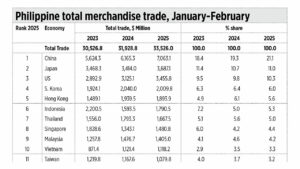China’s trade and their rising industrial-energy capacity

BEIJING — This is the first time I have set foot in the capital city of China. I am here to study some infrastructure, commercial, and energy facilities of China and I hope to draw new lessons based on actual observations to complement my economic and statistical research of international economics and business.
Last week, on March 28, the Philippine Statistics Authority (PSA) released the country’s merchandise trade data for February. I downloaded the excel file and went back to the February 2024 file that includes comparable data for February 2023. So, the January-February data of those three years are now available. I then added the exports plus imports to get total trade of the Philippines per major country trade partner.
Several important trends are shown. One, our total trade has been growing moderately by an average of 4.8% a year in 2024 and 2025. Two, China’s share is rising, from 18.4% of the total in 2023 to 21.1% in 2025. Three, the combined share of Japan and the US, 21.3% in 2025, is equivalent to China’s share. Four, the share of Hong Kong is rising while Taiwan’s share is falling (see the table).
This trend in our international trade should have some impact in our industrial, foreign affairs, and even defense policies. The consumption pattern of our businesses and households is towards buying products made or sourced in China and Hong Kong. Meanwhile, our foreign affairs and defense policies have somewhat antagonistic attitudes towards China. I noted this trend in a couple of recent articles: “On GDP size, exports, FDI and electricity generation” (March 18) and “Exports and life expectancy: some global trends” (March 25).
HONG KONG MODERNIZATIONI went to Hong Kong first to meet some friends in the economics and research consultancy profession. The Hong Kong airport alone still fascinates me — it is so huge, both the runways and passenger terminals. When I went to Argentina last December to attend the free market Tholos Forum 2024, my flight passed by Ethiopia, Sao Paulo in Brazil, then Buenos Aires. I noted that the space and evening lights of those three international airports combined would perhaps be smaller than Hong Kong airport.
The spacious and fast airport train, the huge, tall, long bridges that connect several islands, the underground tunnels and the subway train system, the elaborate highway interchanges, the bright lights of the streets and buildings that are open the whole night, the double-decker buses — they are all evidence of a prosperous and abundant economy and a fast-paced city life.
BEIJING MODERNIZATIONI got to see many big cities below the plane as it started its descent after a more than three-hour flight from Hong Kong to Beijing. I was surprised by the large swathes of high-rise buildings, straight and wide highways and rail systems, including long tunnels under the mountains, and elaborate electrical towers and pylons that crossed mountains and flatlands.
Beijing airport is also huge but not as modern-looking as the Hong Kong airport. There were also fewer planes and passengers than in Hong Kong. The highway from the airport to the city was wide and smooth, but the traffic was moving slowly even on a Sunday night, there were no small public transportation options like jeepneys and tricycles, and very few motorcycles.
Department of Budget and Management (DBM) Secretary Amenah F. Pangandaman would be happy if the public works department and local governments built similarly smooth and wide public roads because the DBM is releasing more than a trillion pesos a year now for these two entities alone.
My local host said that Beijing’s subway train system — all 880 kilometers of it — is elaborate and modern. That distance is farther than Manila is to Ilocos, and that is the Beijing subway system alone.
ELECTRICITY GENERATIONI noted in my March 18 piece that “the Philippines’ total generation of 119 terawatt-hour (TWh) in 2023 was equivalent to only five days of China’s generation” of 9,456 TWh. Of this, 61% is generated by coal-powered plants.
The Philippines’ largest coal plant is Bataan’s GN Power Dinginin (GNPD), owned by Aboitiz Power, which produces 1,336 megawatts (MW) of electricity. In 2024 alone, China constructed enough new coal plants to produce 94,500 MW of electricity. That means they built an equivalent of 71 GNPD-sized coal plants last year. And no more GNPD-size coal plant is forthcoming in the Philippines.
We should aspire for more economic prosperity, material and tangible wealth in the Philippines, not just psychological or sociological happiness of the people. We should aspire to have more modern airports, seaports, tollroads, train systems, huge coal and gas plants, wide and smooth public roads in both urban and rural areas, and so on. This way, growth will be sustained and be felt by everyone as people aspire to uplift their social and economic well-being.
Bienvenido S. Oplas, Jr. is the president of Bienvenido S. Oplas, Jr. Research Consultancy Services, and Minimal Government Thinkers. He is an international fellow of the Tholos Foundation.




